Culture of Gambia
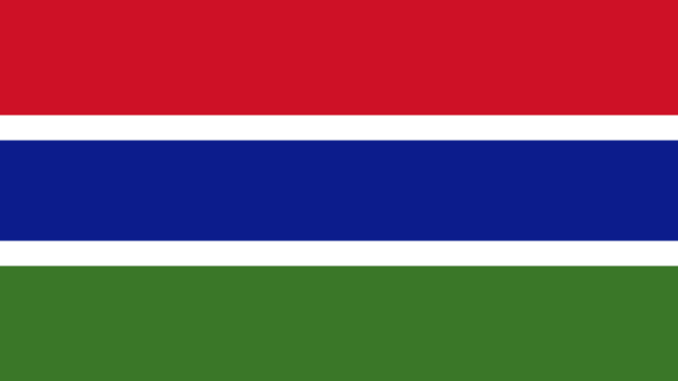
Culture Name
Gambian
Alternative Names
The Gambia
Orientation
Identification. Republic of The Gambia is the official name of The Gambia. The country was named after the Gambia River, which flows from East to West for three hundred miles, the entire length of the country. Gambia is a small country with a population of 1.2 million. It straddles the Gambia River on either side.
Location and Geography. Gambia is on the western coast of Africa, surrounded on three sides by Senegal. Situated on a sandy peninsula between the mouth of the Gambia River and the Atlantic Ocean, Banjul, the capital, was founded by the British as Bathurst in 1816 as a base for suppressing the slave trade. The Gambians changed its name to Banjul in 1973, eight years after independence. Gambia is the smallest country in Africa with a total area of 4,363 square miles (11,300 square kilometers), slightly less than twice the size of Delaware. Gambia has the typical West African climate: there is a hot, rainy season (June to November), and a cooler, dry season (November to May). It is a relatively flat land with its lowest point being sea level at the Atlantic Ocean with the maximum elevation being 174 Feet (53 meters) in the surrounding low hills. The Gambia River is the dominant geographical feature of the country, providing both a useful means of transportation and irrigation as well as a rich ground for fishing, boating, and sailing.
Demography. The total population of Gambia, from a July 1999 estimate, is 1,336,320. The main ethnic groups in Gambia are the Mandingo (42 percent of the overall population), Wolof (16 percent), Fulani (18 percent), Jola (10 percent), Serahuli (9 percent), other Africans (4 percent), and non-Africans (1 percent). By age, the population is distributed as follows: (per a 1999 estimate) 0–14 years, 46 percent (male, 305,839; female, 304,905); 15–64 years, 52 percent (male, 341,947; female, 348,163); 65 years and over, 2 percent (male, 18,706; female, 16,760). The population is growing at a rate of 3.35 percent per year. The birthrate is 42.76 births per 1,000 population, and the death rate is 12.57 deaths per 1,000. The infant mortality rate is 75.33 deaths per 1,000 live births. Average life expectancy is 54.39 years; for women it is 58.83 years compared with 52.02 years for men.
Linguistic Affiliation. English is the official language but indigenous languages include Mandinka, Wolof, and Fula.
History and Ethnic Relations
Emergence of the Nation. The first written mention of Gambia is in the work of Hanno the Carthaginian in his writings about his voyage to West Africa in 470 B.C.E. Gambia at various times was part of different West African kingdoms, including the kingdoms of Foni, Kombo, Sine-Saloum, and Fulladou. Its various ethnic groups migrated to Gambia from different areas of West Africa. Trade was vital to Gambia, especially trade with Ghana, Songhai, and the Mali Empire (between the Atlantic Ocean and the River Niger), Kanem-Bornu, and the Hausa States.
By 1500 C.E. , trade with Europe was established. In the 1450s, Venetian explorer Alvise Cadamosto, under commission from Portugal, was the first European to reach the Gambia River. The English were not far behind, coming to West Africa to buy gold and spices. The Portuguese successfully barred English trade for one hundred years. At the end of the sixteenth century, however, the English and French managed to establish trade in the area.
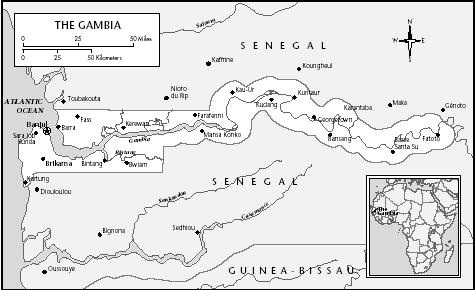
Gambia
After numerous conflicts the British, in the Treaty of Versailles of 1783, gained control of the Gambia River. In 1807, the British abolished slave traffic on the river.
Muslims were involved in the trans-Saharan slave trade, as well as more legitimate trade. Along with trade, merchants brought Islam and Muslim culture to Gambia. More directly, Muslim Berbers from Mauritania were the direct agents of Islam to the Gambia and Senegal. As in other parts of West Africa, rulers in the Gambia became Muslims and used its law, the Shariya, to consolidate their power.
Gambia became part of a larger British colony, the Province of Senegambia, which included present-day Senegal and Gambia. The Senegambia has the distinction of being the first British colony in Africa. The French took Senegal in 1799, and the British agreed to base their trade around Bathurst and Fort James. In 1821, Gambia became a crown colony as part of the colony of Sierra Leone. In 1843, however, the Gambia was separated from Sierra Leone. The Gambia became a British Protectorate in 1888.
The British did not begin to develop Gambia properly until after World War II when administration posts were set up. Internal self-government came in 1963. Independence Day was 18 February 1965 when Gambia became a sovereign republic within the British Commonwealth of Nations. In 1969, Gambia and Senegal formed Senegambia, but in 1982 the confederation was dissolved with the mutual consent of both partners.
National Identity. Although the Gambia is comprised of people of many different ethnic groups, there seems to be relative harmony among them and among people of different religions. Gambia has a generally good human rights record, and there is a great desire among its peoples to have the country taken seriously in the world community.
Ethnic Relations. Gambia is a multiethnic country; major ethnic groups include the Fula, Jola, Mandinka, Serahule, and Wolof. There is no part of The Gambia that is inhabited by one single ethnic group. This close dwelling has led to a sharing of many cultural traits among the groups, which has led to a movement toward a Gambian national culture. There has been a concentrated effort to represent the various minority ethnic groups in government. In addition to indigenous ethnic groups, there has also been an annual migration from Senegal, Guinea, and Mali. Many people from those countries come to trade in groundnuts (peanuts) and stay to settle.
The Wolof and the Mandinka are the major ethnic groups. The Wolof live mainly in the capital, Banjul. The Mandinka are the largest single ethnic group in the country. These groups represent the former Empire of the Wolof in the Senegambian region and the Mandingo Empires of Mali and Songhai. Creoles form a large element within the local elite. Additionally, there are Mauritanians, Moroccans, and Lebanese in the country. These groups are mainly traders and shopkeepers. English is commonly spoken by members of all ethnic groups since it is the official language of the country. Each ethnic groups speaks its own language as well. Harmony among ethnic groups is the general rule, so much so that Gambia is considered to be a melting pot of West African ethnic groups.
Urbanism, Architecture, and the Use of Space
Banjul is the only real urban center in Gambia. It has a typical former British colonial feel to it. The administrative buildings are built in the center of the city, tending toward Edwardian "majesty." Many of the buildings are done in pastel colors with huge gardens. The colonial bungalow is a typical form of architecture. Squatter settlements resembling poorer versions of rural settlements dot the area. There are large public areas in the British style.
Food and Economy
Food in Daily Life. Not surprisingly, following two hundred years of British colonialism, Western food is available in Gambia. Gambian traditional food includes benachin ("Jollof rice," a mixture of spiced meat and rice cooked with tomato puree and vegetables), base nyebe (rich stew of chicken or beef with green beans and other vegetables), chere (steamed millet flour balls), domodah (meat or chicken stewed in groundnut butter and served with rice), plasas (meat and smoked fish cooked in palm oil with green vegetables) served with fu-fu (mashed cassava), and chura-gerteh (a sweet porridge consisting of pounded groundnuts and rice and served with yogurt or sour milk). The most commonly eaten fruits are mangoes, bananas, grapefruit, papayas, and oranges.
Food Customs at Ceremonial Occasions. Food is important at ceremonial occasions such as naming ceremonies, betrothals, marriages, and deaths. At these occasions, meat is served along with Jollof rice and fruit. The more food, the more successful the occasion.
Basic Economy. About 80 percent of the population is comprised of subsistence farmers. A majority of these subsistence farmers are women. Groundnuts make up the majority of export products. Millet is also grown widely in the country. There is very little manufacturing in the country. The Fulani specialize in dairy products and trade them for grain and other products. The fact that there is very little manufacturing in Gambia has resulted in liberal trade policies and the encouragement of tourism. The rapidly growing population of 1.3 million is divided between a rural majority and a growing urban minority. The private sector of the economy is led by tourism, trading, and fisheries. This sector is healthy and is experiencing modest growth. Gambia's high population growth rate has diluted the positive effects of economic expansion. Gambia's per capita gross domestic product is about $360 (U.S.). About 23 percent of the population is in the agricultural sector, 13 percent in the industrial sector, and 64 percent in the service sector.
Land Tenure and Property. All ethnic groups have traditional patterns of inheritance in which priority is given to the male survivors. Islam, however, under the Shari'a law, provides a portion of the estate for widows. Land is traditionally distributed by need, although modern British law is taking root. In the modern sphere, British property law is exerting a greater influence.
Commercial Activities. There is relatively little commercial activity in Gambia. Gambia does rely heavily on trade to obtain industrial goods and, therefore, trades agricultural products, mainly peanuts, to obtain foreign capital. Trade laws are quite liberal.
Major Industries. Gambia has a mining industry that is in its early stages of development in addition to a small oil industry. Electricity is provided by the parastatal utility Gambia Utility Corporation. There have been attempts to develop the fisheries industry and local food processing. Tourism plays a dominant role in the nation's economic development.
Trade. Gambia exported $110.6 million worth of products and imported $164 million in 1994. The bulk of the imported items were comprised of petroleum
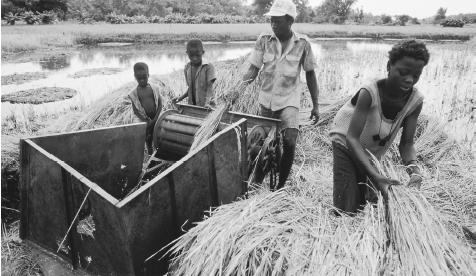
Workers harvesting rice with threshing machines in Kunuku. About 80 percent of Gambians are subsistence farmers.
products, processed food, and manufactured goods.
Division of Labor. Women have entered the modern sphere on a basis of equal pay. Most women, however, are involved in the subsistence farming sector. As in much of West Africa, women do the majority of the day-to-day farming, while men do the heavy clearing.
Social Stratification
Classes and Castes. With the exception of the Fulani, ethnic groups are highly stratified. This stratification is a remnant of the great empires that once ruled the country. In each group, status was essentially inherited from the father. The rulers also inherited their statuses, and administered a feudal domain. The majority of people were peasant farmers who owed various services to their rulers.
Symbols of Social Stratification. Elaborate rituals of rank prevailed in the past. Generally, those of the lower orders abased themselves through prostration in front of those who outranked them. Differences in clothing, food, and the wearing of precious stones also were signs of privilege. Visits to Mecca set some Muslims apart from others.
Political Life
Government. Gambia currently has a multiparty political system. The Constitution of the Second Republic of Gambia provides for elections by universal suffrage for adults eighteen and older. The ballot is a secret one, and elections must be held every five years. The country's National Assembly includes forty-five elected members and four nominated members. The president, popularly elected for a five-year term, is both the chief of state and head of government.
The country's administration is divided into the capital territory (the seat of government), the adjoining Kombo Saint Mary area, and the provinces. Each province has five divisions, each one headed by a commissioner. These divisions are further subdivided into districts locally administered by head chiefs.
The judicial system resembles that of other common law jurisdictions. There is a single system of courts, forming a hierarchy. The subordinate courts consist of Khadis' courts, district tribunals, and magistrate courts. At the higher level are the Supreme Court, the Court of Appeal, and the Privy Council. The latter is the highest court of appeal for the Gambia.
Leadership and Political Officials. In July 1994, junior officers overthrew the government. Lieutenant Yaya Jammeh (later Captain and then Colonel) led the coup. The International community condemned the coup since Gambia had been a model of democracy for over 30 years. It also had been a model of human rights. In spite of promises, there has not yet been a return to political democracy. Rights are denied to opposition politicians, and meetings and a free press are banned. President Jammeh's party, the Alliance for Patriotic Reorientation and Construction (APRC), controls thirty-three of forty-five elected assembly seats and four members appointed by the President. Women are free to participate in government but are poorly represented there. There is only one woman in the assembly. However, the Vice President (who is also Minister of Health) is a woman. Three cabinet members are also women.
Social Problems and Control. The major social problems are poverty, disease, and lack of economic development. A 1994 military coup was an attempt to address these problems by clearing away corruption that stifled democracy. In 1996 and 1997 free elections were held.
Military Activity. Gambia is not at war with any country. Its military is well trained and has returned power to civilian rule. Its military branches include the army (including a marine unit), national police, and national guard. There are currently approximately 150,000 males aged fifteen to forty-nine who are fit for military service. The Gambia spends about $1.2 million on the military, about 2 percent of its budget.
Social Welfare and Change Programs
Like many African states, Gambia has many serious welfare problems. The government is on record as being dedicated to change, and their particular attention is given to children's welfare. The Department of Education and the Department of Health, Social Welfare, and Women's Affairs are heavily funded. However, lack of sufficient resources hinders the full implementation of programs. For example, although free, compulsory primary education is the law of the land, there are insufficient resources to implement the program. In February 1998, the president ended fees for the first six years of schooling. There is even less opportunity for secondary education. Female participation in education is rather low. There are two men for every woman in education, and the ratio is even lower in rural areas.
The government is less concerned with the welfare of children in distress, considering this matter to be a case for parental and family concern. Similarly, although the government requires child support for the children of divorced parents, the requirement is rarely enforced. However, authorities do typically get involved in cases of child abuse that come officially to their attention, although there is little pattern of such abuse. The tourist industry has increased begging and child prostitution. Female genital mutilation (FGM) exists and is widespread. Estimates are that 60 to 90 percent of women in Gambia have been subjected to FGM. Seven of the nine major ethnic groups support FGM. The government considers FGM to be an integral part of the cultural system.
There are no government provisions to aid the disabled. However, there appears to be no discrimination against those people who can perform work. Those who cannot perform work are left to private charity, which often means begging.
Nongovernmental Organizations and Other Associations
Gambia has a number of religious and secular NGOs. There are Muslim brotherhoods, Catholic missions, and international agencies working to care for various problems and to aid development efforts.
Gender Roles and Statuses
Traditionally women are subordinate to men. Polygyny is prevalent and even in groups without traditional patrilineal descent, Islam has strengthened male control of women. In the modern sector, women have equal rights in employment as they have in government. However, relatively few of Gambia's women operate in the modern sector. Most are engaged in subsistence farming. Inheritance in the traditional system also favors women.
Division of Labor by Gender. Women do most of the farming. At one time, women's farm incomes outstripped male incomes in general. Male landholders, however, attempted to use the new ecology movement as a means of erasing women's social and economic gains. Men control tree crops in Gambia, while women control garden farms.
The new ecology movement in anthropology relates to a deeper understanding of the relationship of technology and social organization to the environment. Conscious choices and preferences, as well
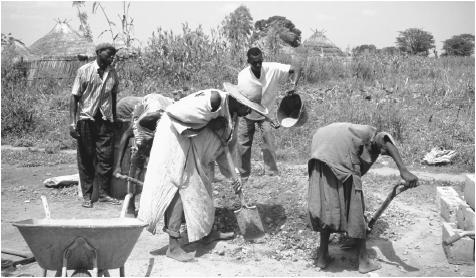
Villagers building a water well. Gambia's dry season runs from November to May.
as relationships between different groups, lead to changes in the physical environment.
The Relative Status of Women and Men. In law, there is equality of the sexes. In practice, men tend to exert control over their wives and female children. At the same time, there is a growing women's movement in Gambia.
Marriage, Family, and Kinship
Each ethnic group has its own marriage, residence, and kinship patterns. Additionally, Islam and Christianity have their own regulations. Any particular marriage pattern, kinship system, or residence pattern depends upon a confluence of variables.
Marriage. Marriage in Gambia is regulated by either customary, Shari'a (Muslim), or general law. Customary law is reserved for all non-Muslims and covers inheritance, land tenure, tribal and clan leadership, as well as other relationships. Shari'a law is primarily for Muslims and covers marriage and divorce. General law is based on British law. Rape is illegal in the case of both married and unmarried women and, along with assault, is a crime. The law does not differentiate between married and unmarried women in this regard. Any person who has carnal knowledge of a girl under the age of 16 is guilty of a felony (except in the case of marriage); incest is also illegal. These laws are generally enforced.
Polygyny is the general rule for each of Gambia's ethnic groups. Similarly, each group has arranged marriages. Married women in monogamous or polygynous unions have property and other rights, including the right to divorce their husbands. Their husbands, however, are free to marry other wives without their permission. Shari'a law usually is applied in divorce and inheritance matters for Muslims, who make up approximately 90 percent of the population. Women normally receive a lower proportion of assets distributed through inheritance than do male relatives.
Employment in the formal sector is open to women at the same salary rates as men. No statutory discrimination exists in other kinds of employment. However, women generally are employed in endeavors such as food vending or subsistence farming.
Domestic Unit. There are variations in the domestic units of the various ethnic groups of Gambia. The social structure of the pastoral Fulani is egalitarian, in marked contrast to that of other Muslim groups, such as the Hausa, and to most sedentary Fulani. The influence of Islam on kinship patterns is
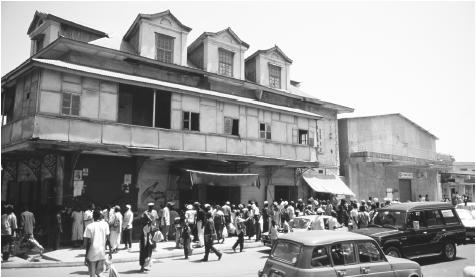
Shoppers and cars in downtown Banjul. The capital is Gambia's only urban center.
evident in the general preference for cousin and other intralineage marriages. Most men are polygynous, the typical household unit comprising the family head, his wives, and unmarried children. Other Islamic groups, such as the Soninke, follow the same general pattern. The Wolof are noted for their double descent kinship system. A household unit usually has a nuclear family or a polygynous unit. There may also be other close kin living together.
Kin Groups. The vast majority of Gambia's ethnic groups are patrilineal and patrilocal. This tendency toward male groups is strengthened through Islamic affiliation, as 90 percent of the population is Muslim. Even the Soninke—who practice double descent—have developed a bias toward the patriline.
Socialization
Socialization is generally through imitation and proverbs. Older children, especially girls, care for their younger siblings. Generally, male children accompany their fathers, while girls follow their mothers. Segregation by sex is common, and children tend to follow their parents example and occupations. Males tend to be dominant over females. Religion plays its role in supporting the established order. European missionaries have helped bring in Western ideas and modern employment options to the country.
Infant Care. Infant care generally follows West African patterns. Women have general responsibility for child care. Young girls carry their siblings around with them. Any community member can correct any child or commandeer it for reasonable help. Folktales and proverbs illustrate moral ideas.
Child Rearing and Education. Education, in theory, is free and universal for primary school. In practice, that is not always the case. Urban areas tend to have better schools and more reliable attendance.
Literacy in Gambia is defined as those fifteen and older who can read and write. In the total population, the literary rate is 38.6 percent; by gender, it is 52.8 percent for males and 24.9 percent for females.
Higher Education. Relatively few of Gambia's people advance to higher education. In fact, there are no universities in Gambia, but in the late 1990s, university extension programs were offered for the first time.
Etiquette
In general, Gambian ethnic groups prize tranquility of life, and their manners tend to ease the attainment of that goal. Gambians tend to be soft-spoken and gentle in demeanor, seeking to avoid noisy conflicts and striving toward quiet settlement of disputes. Greetings tend to be drawn out while people ask about one another's families.
Religion
Religious Beliefs. The religious distribution is Muslim, 90 percent; Christian, 9 percent; and indigenous believers, 1 percent.
Religious Practitioners. There are a number of traditional religious practitioners as well as Muslim imams, Catholic priests, and Protestant ministers. Each traditional group has its own practitioners.
Rituals and Holy Places. There are no places that are sacred to all peoples; each ethnic group has its own particular local shrines. Muslims go to Mecca on pilgrimage and Catholics increasingly travel to Rome and other Catholic holy places.
Death and the Afterlife. Each group has its own particular beliefs concerning the afterlife and death. Catholics and Muslims tend to combine the particular traditional beliefs of their ethnic group with more universal Catholic or Muslim beliefs.
Medicine and Health Care
Gambia suffers from the usual list of tropical diseases, many of them water borne. Malaria is endemic; blindness afflicts a large percentage of the population. Modern health care is found in urban centers and sporadically in villages.
Secular Celebrations
Independence Day is 18 February. There is a six-month "tourist" festival based on the television series and book Roots. It runs from June to January, with variable dates. Christmas, New Year's, and other general holidays are also celebrated.
The Arts and Humanities
Support for the Arts. There is some government support but the Gambia is a poor country and can spare little for the arts.
Literature. Increasingly, there are collections of folk tales, poetry accompanied by the Kora, a lutelike instrument, and novels. No Gambian novelist has reached the stature of other Africans, such as Chinua Achebe or Wole Soyinka, but there are promising young Gambian authors.
Graphic Arts. The masks of Gambia are well known and appreciated.
Performance Arts. The Kora, a lutelike instrument, accompanies much singing and dancing. There are many collections of these performances on audio and videotape.
The State of the Physical and Social Sciences
The Gambian government supports physical and social research for its various development projects. There is a strong tradition of academic freedom in the country.
Bibliography
Davison, Jean, ed. Agriculture, Women, and Land: The African Experience , 1988.
Gray, John. Kora Land Poems , 1989.
Kelly, Robert, Debra Ewing, Stanton Doyle, and Denise Youngblood, eds. Country Review: Gambia, 1998/ 1999 , 2000.
Magel, Emil A., trans. Folktales from the Gambia: Wolof Fictional Narratives , 1984.
Marcie-Taylor, C. G. N., ed. The Anthropology of Disease , 1993.
Mark, Peter. The Wild Bull and the Sacred Forest: Form, Meaning, and Change in Senegambian Initiation Masks ,1992.
McPherson, Malcolm F., and Steven C. Radelet, eds. Economic Recovery in the Gambia: Insights for Adjustment in Sub-Saharan Africa , 1996.
Schroeder, Richard A. Shady Practices: Agroforestry and Gender Politics in the Gambia , 1999.
Sowa, Shiona, et al. Trachoma and Allied Infections in a Gambian Village , 1965.
